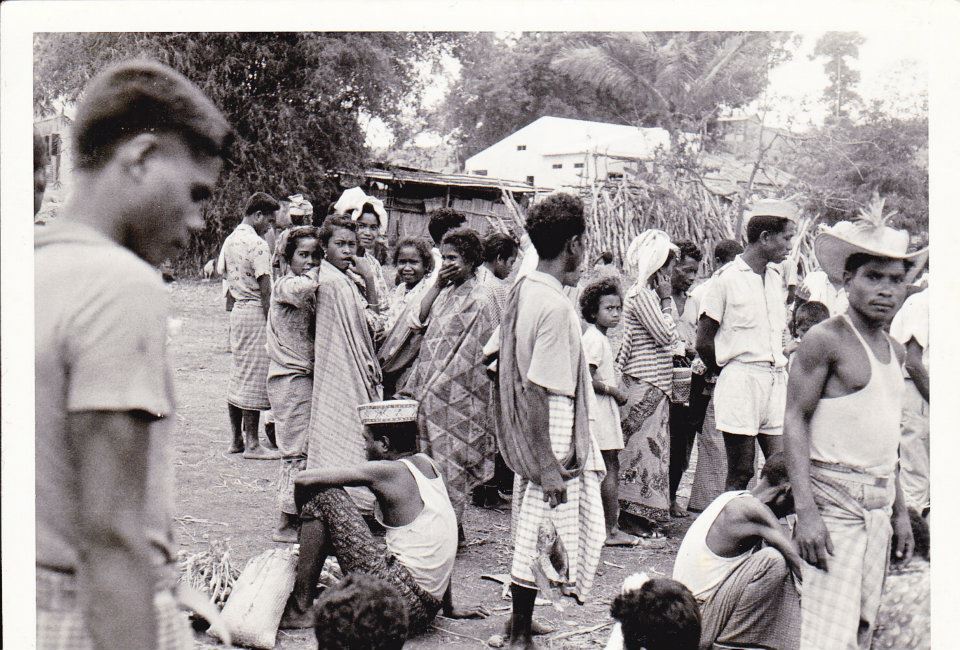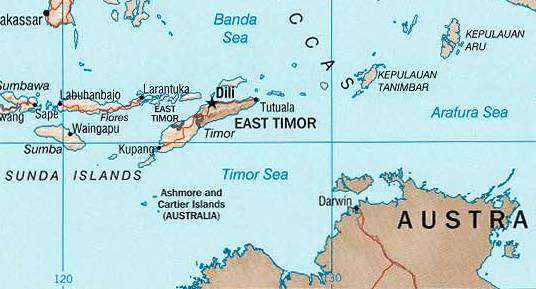|
Bunaq
The Bunak (also known as Bunaq, Buna', Bunake) people are an ethnic group that live in the mountainous region of central Timor, split between the political boundary between West Timor, Indonesia, particularly in Lamaknen District and East Timor. Their language is one of those on Timor which is not an Austronesian language, but rather a Papuan language, belonging to the Trans–New Guinea linguistic family. They are surrounded by groups which speak Malayo-Polynesian languages, like the Atoni and the Tetum. According to ''Languages of the World'' (Voegelin and Voegelin, 1977), there were about 100,000 speakers of the language, split evenly between the two nations. Settlement area Today's settlement area of the Bunak people is located in the mountains of central Timor, ranging from the East Timorese town of Maliana in the north to the Timor Sea in the south, where both the Bunak and the Tetun communities often live side by side in coexistence. The Bunak people are isol ... [...More Info...] [...Related Items...] OR: [Wikipedia] [Google] [Baidu] |
Bunak Language
The Bunak language (also known as Bunaq, Buna', Bunake, pronounced ) is the language of the Bunak people of the mountainous region of central Timor, split between the political boundary between West Timor, Indonesia, particularly in Lamaknen District and East Timor. It is one of the few on Timor which is not an Austronesian language, but rather a Papuan language of the Timor-Alor-Pantar language family. The language is surrounded by Malayo-Polynesian languages, like Uab Meto and Tetum. Bunak distinguishes between animate and inanimate noun classes. Phonology * Plosive sounds /p t k/ can be heard as unreleased allophones ̚ t̚ k̚ in word-final position. * Sounds /b d ɡ/ can be heard as � r ɣin intervocalic positions. * /ɡ/ can be heard as ʒwhen preceding /i/. * /z/ can have allophones � dʒin free variation. * /tʃ/ is heard as when preceding /i/. * /l/ in word-final position can also be heard as a fricative �in free variation. Schapper (2009). Pronouns P ... [...More Info...] [...Related Items...] OR: [Wikipedia] [Google] [Baidu] |
Papuan Language
The Papuan languages are the non- Austronesian and non-Australian languages spoken on the western Pacific island of New Guinea in Indonesia and Papua New Guinea, as well as neighbouring islands, by around 4 million people. It is a strictly geographical grouping, and does not imply a genetic relationship. The concept of Papuan (non-Austronesian) speaking Melanesians as distinct from Austronesian-speaking Melanesians was first suggested and named by Sidney Herbert Ray in 1892. New Guinea is the most linguistically diverse region in the world. Besides the Austronesian languages, there are some (arguably) 800 languages divided into perhaps sixty small language families, with unclear relationships to each other or to any other languages, plus many language isolates. The majority of the Papuan languages are spoken on the island of New Guinea, with a number spoken in the Bismarck Archipelago, Bougainville Island and the Solomon Islands to the east, and in Halmahera, Timor and the Alor ... [...More Info...] [...Related Items...] OR: [Wikipedia] [Google] [Baidu] |
Papuan Languages
The Papuan languages are the non- Austronesian and non-Australian languages spoken on the western Pacific island of New Guinea in Indonesia and Papua New Guinea, as well as neighbouring islands, by around 4 million people. It is a strictly geographical grouping, and does not imply a genetic relationship. The concept of Papuan (non-Austronesian) speaking Melanesians as distinct from Austronesian-speaking Melanesians was first suggested and named by Sidney Herbert Ray in 1892. New Guinea is the most linguistically diverse region in the world. Besides the Austronesian languages, there are some (arguably) 800 languages divided into perhaps sixty small language families, with unclear relationships to each other or to any other languages, plus many language isolates. The majority of the Papuan languages are spoken on the island of New Guinea, with a number spoken in the Bismarck Archipelago, Bougainville Island and the Solomon Islands to the east, and in Halmahera, Timor and the A ... [...More Info...] [...Related Items...] OR: [Wikipedia] [Google] [Baidu] |
Bobonaro
Bobonaro is a town in Bobonaro Subdistrict, Bobonaro District, East Timor., United States National Geospatial-Intelligence Agency The district capital is not in Bobonaro, but is in Maliana Maliana is a city in East Timor, 149 kilometers southwest of Dili, the national capital. It has a population of 22,000. It is the capital of the Districts of East Timor, district of Bobonaro District, Bobonaro and Maliana Subdistrict, and is ... instead. Bobonaro suco has 1,532 inhabitants. Notes and references Populated places in East Timor Bobonaro Municipality {{EastTimor-geo-stub ... [...More Info...] [...Related Items...] OR: [Wikipedia] [Google] [Baidu] |
Malaka Regency
Malaka Regency is a regency in the province of East Nusa Tenggara, Indonesia. The regency was established on 14 December 2012, comprising twelve districts which had formerly been the southern part of Belu Regency Belu Regency is a regency in East Nusa Tenggara province of Indonesia. Established on 20 December 1958, Belu Regency has its seat (capital) in the large town of Atambua. In December 2012 a separate Regency - Malaka Regency - was created from t .... The area now comprising the new Regency had 164,134 inhabitants at the 2010 Census, which had risen to 183,900 at the 2020 Census; the official estimate as at mid 2021 was 197,022. The capital of the regency is the town of Betun. Administration The new Malaka Regency is composed of twelve districts (''kecamatan''), tabulated below with their areas and populations at the 2010 Census and the 2020 Census, together with the official estimate as at mid 2021.Badan Pusat Statistik, Jakarta, 2022. The table also includes the ... [...More Info...] [...Related Items...] OR: [Wikipedia] [Google] [Baidu] |
Belu Regency
Belu Regency is a regency in East Nusa Tenggara province of Indonesia. Established on 20 December 1958, Belu Regency has its seat (capital) in the large town of Atambua. In December 2012 a separate Regency - Malaka Regency - was created from the twelve districts that formerly comprised the southern half of Belu Regency. Belu means friend in Tetum. The residual part of Belu Regency had a population of 188,163 at the 2010 Census, which rose to 206,476 at the 2015 Census and to 217,973 at the 2020 Census. The official estimate as at mid 2021 was 227,397. Administrative Districts The Belu Regency was until 2013 divided into twenty-four districts (''kecamatan''), but in December 2012, the twelve southern ''kecamatan'' were removed to form the new Malaka Regency, leaving the twelve northern ''kecamatan'' in Belu Regency. The residual Belu Regency is thus composed of twelve districts (''kecamatan''), tabulated below with their areas (in km2) and their populations at the 2010 Census ... [...More Info...] [...Related Items...] OR: [Wikipedia] [Google] [Baidu] |
Manufahi District
Manufahi (, ) is one of the municipalities of East Timor. It has a population of 53,691 (2015 census) and an area of 1,323 km2. The capital of the municipality is Same. Etymology The present name of the municipality, ''Manufahi'', is derived from ''Maun Fahe'', the Tetum language expression for 'divided brothers'. The name originated in a legend that tells of a fight between two related tribes, or a group of siblings. Eventually, the protagonists agreed to subject themselves to a single ruler. During the Portuguese colonial era, the then district bore the name of its main town, Same. The present name was adopted on the basis of the divided brothers legend. However, it was misspelled, and the Tetum language meaning of the misspelled name is 'pig chicken'. Efforts are being made to correct the name. However, there is also a legend that in the '' suco'' of a rooster once flew down from a mountain, landed on the back of a pig, and then travelled with the pig to many pla ... [...More Info...] [...Related Items...] OR: [Wikipedia] [Google] [Baidu] |
Tetun
, nativename=Tetun , states= Indonesia East Timor , speakers=, mostly in Indonesia , date=2010–2011 , ref=e18 , speakers2=50,000 L2-speakers in Indonesia and East Timor , familycolor=Austronesian , fam2=Malayo-Polynesian , fam3= Central–Eastern , fam4= Timor–Babar , fam5=Tetumic , dia1=Belunese (''Tetun Belu'') , dia2=Terik (''Tetun Terik'') , nation= , minority= (East Nusa Tenggara) , iso2=tet , iso3=tet , glotto=tetu1245 , glottorefname=Tetum , map=Tetum Terik.png , mapcaption=Distribution in East Timor of ''Tetum Belu'' (west) and ''Tetum Terik'' (southeast). The majority of Tetun speakers, who live in West Timor, are not shown. , nativename=''Tetun Dili, Tetun Prasa'' , states=East Timor , speakers= , date=2009 , ref= , speakers2 = L2: in East Timor , familycolor=Austronesian , fam2=Malayo-Polynesian , fam3= Central–Eastern , fam4= Timoric , fam5=Oceanic , fam6=Tetumic , dia1=Belunese (''Tetun Belu'') , dia2=Terik (''Tetun Terik'') , script=Latin (Tetum alphabet) ... [...More Info...] [...Related Items...] OR: [Wikipedia] [Google] [Baidu] |
Mambai People (Timor)
The Mambai (Mambae, Manbae) people are the second largest ethnic group after the Tetum Dili people in East Timor. Originally, they were known as the Maubere by the Portuguese. ''Maubere'' or ''Mau Bere'' is a widespread male first name among the Mambai people. Settlement area The Mambai number about 80,000Clifford Sather and James J. Fox (eds), Origins, Ancestry and Alliance: Explorations in Austronesian Ethnography', ANU E Press, 2006, Chapter 7. from the interior of Dili District to the south coast of the territory, especially in the districts of Ainaro and Manufahi. Its principal centers are Ermera, Aileu, Remexio Administrative Post, Turiscai, Maubisse, Ainaro and Same, East Timor. Among the East Timorese exiles in Australia, the Mambai people are one of the main groups. Culture The Mambai language belongs to the Central–Eastern Malayo-Polynesian languages of the Timoric languages branch. It is the second most common mother tongue in East Timor with 195,778 speakers. C ... [...More Info...] [...Related Items...] OR: [Wikipedia] [Google] [Baidu] |
Kemak People
The Kemak (, also known as Ema) people are an ethnic group numbering 80,000 in north-central Timor island. They primarily live in the district of Bobonaro, East Timor, while the rest live in the East Nusa Tenggara province of Indonesia. They are close to the Tetum people. The Kemak people speak the Kemak language. Kemak people are one of the smallest of the 14 Austronesian subgroups in Timor. Most of them are adherents of traditional beliefs, while part of them profess to the Catholic faith. Territorial community is headed by a leader, divided into genera. There are three levels of conjunctions. The "private" type of group corresponds to the level of ''uma'' or house. It does not only mean housing, but its category includes the exogamous groups of older and younger brothers who share a common ancestor. The "collective" type refers to the Morobe community, which encompasses 7 villages containing mainly 3 houses, and united by a common ritual cycle. Settlement area For the most par ... [...More Info...] [...Related Items...] OR: [Wikipedia] [Google] [Baidu] |
Timor Sea
The Timor Sea ( id, Laut Timor, pt, Mar de Timor, tet, Tasi Mane or ) is a relatively shallow sea bounded to the north by the island of Timor, to the east by the Arafura Sea, and to the south by Australia. The sea contains a number of reefs, uninhabited islands and significant hydrocarbon reserves. International disputes emerged after the reserves were discovered resulting in the signing of the Timor Sea Treaty. The Timor Sea was hit by the worst oil spill for 25 years in 2009. It is possible that Australia's first inhabitants crossed the Timor Sea from the Malay Archipelago at a time when sea levels were lower. Etymology The Timor Sea is named after Timor, the island on the other side of the sea's northern coastline. The island's name is a variant of , Malay for "east". In Tetum, the expression () is often used to refer to the Timor Sea. The counterpart of that body of water, the ' Ombai-Wetar Strait', which has smaller waves, is less turbid, and washes most of Timor ... [...More Info...] [...Related Items...] OR: [Wikipedia] [Google] [Baidu] |






